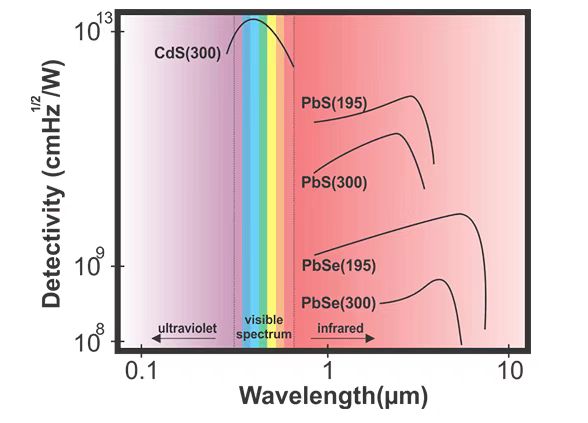What makes cadmium selenide and cadmium sulfide such appealing semiconductors to make photocells out of?
Cadmium sulfide and Cadmium selenide turn conductive in the visible wavelengths, they do this because they are semiconductors and the bandgap is responsive to visible wavelengths.
A photoresistor is made of a high resistance semiconductor. In the dark, a photoresistor can have a resistance as high as several megohms (MΩ), while in the light, a photoresistor can have a resistance as low as a few hundred ohms. If incident light on a photoresistor exceeds a certain frequency, photons absorbed by the semiconductor give bound electrons enough energy to jump into the conduction band. The resulting free electrons (and their hole partners) conduct electricity, thereby lowering resistance. The resistance range and sensitivity of a photoresistor can substantially differ among dissimilar devices. Moreover, unique photoresistors may react substantially differently to photons within certain wavelength bands. Source: Wikipedia Photoresistor.

Source: Optical and photoelectrical properties of CdSxSe1-x films produced by screen-printing technology.
But other direct bandgap semiconductors exist, too, including ones without any highly toxic elements, like gallium antimonide or tin sulfide, or any of the more complex compounds used for thin-film solar cells.
What gives cadmium compounds such an advantage?
What gives cadmium compounds such an advantage?
There are other materials that are responsive, but CdS or CdSe have responsivity in the visible wavelength range, this is useful if you want your device to respond in the same wavelength range that people see in. CdS is the best photosensitive material in the visible range and photodetectors made from CdS are cheap. The alternative would be a photo diode circuit, which is more complex and requires more components.

Source: http://www.resistorguide.com/photoresistor/
First, they were first. As a useful photoresistive material, cadmium et. al. predates silicon devices by decades.
Second, they are not semiconductors. This is one of the main reasons why they are still in demand in areas such as professional audio.
Third, the property change (resistance in this case) from dark to light (dynamic range) is huge. This means that many applications do not need any amplification or other signal processing.
Fourth, they can be made to handle high (compared to silicon devices) voltages, such as offline TRIAC gating.
Fifth, reliability.
As long as EU maintains a Cadmium exception for PV modules and sensors, etc in RoHS, they are still available. These exemptions came with a promise to setup recycling routes.
What makes cadmium selenide and cadmium sulfide such appealing semiconductors to make photocells out of?
Inexpensive sensors with a very high sensitivity of 0.8-Ω/Lux spanning many decades, avoiding the need for amplifiers.
Inexpensive sensors with a very high sensitivity of 0.8-Ω/Lux spanning many decades, avoiding the need for amplifiers.
Final considerations on the inexpensiveness of CdS/CdSe photoresistors. The main characteristic of inexpensiveness of these devices is achieved because CdS and CdSe, despite being semiconductors exactly as GaAs and GaN, need not to be grown as a monocrystalline structure for those applications. Their high basic resistivity is not affected too much by the polycrystalline structure they assume when deposed on insulating or metal substrates by sputtering, vapor deposition or other similar techniques, in order to produce photoresistors. This is a far more economic production process respect the ones required by other semiconductor photodevices.
Latest News
Contact Us
Name: Miss zhao
Tel: +86-13333651153
E-mail: [email protected]
Skype: helenlystone
Add: Shenzhen,China
Link






 Skype Chat
Skype Chat Mail inquiry
Mail inquiry